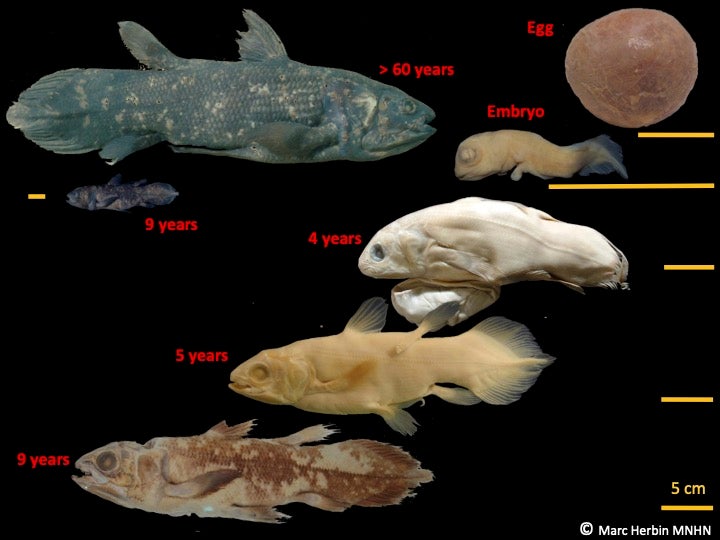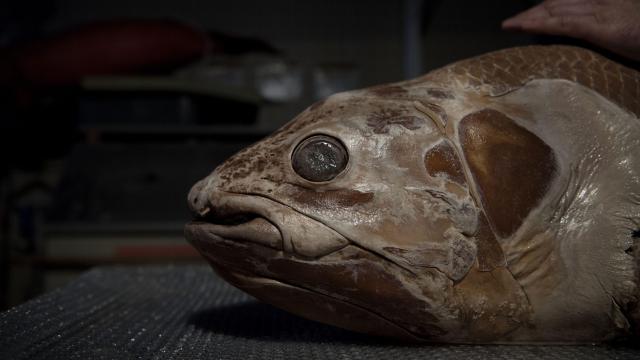A team of French researchers has found that the little-understood coelacanth can live for a century. Not only that, but the fish’s whole lifespan appears to be stretched, as it spends years in the womb and doesn’t fully mature until at least age 45.
Some previous estimates had the coelacanth pegged as a fast-growing, fast-spawning fish, with a lifespan of about 20 years. But some observations of the fish in the wild had raised suspicions that they actually lived much longer than that. The new research, published today in Current Biology, estimates their lifespan at 100 years, based on an inspection of the animal’s scales under polarised light.
For all their fame above the ocean’s surface, the coelacanth’s life history remains something of a black box. The fish was known from fossils and was presumed to have been extinct since the Cretaceous period (around 66 million years ago). But when a fisherman in South Africa pulled up a fresh specimen in 1938, it sent shockwaves through the scientific community. Its midnight blue and pearlescent white scales reminded Marjorie Courtenay-Latimer, the museum curator who first ID’d the captured specimen, of the starry sky. And it is those scales that helped the recent team of researchers figure out the animal’s actual longevity, in a side project they undertook during the pandemic.

“You can make great findings based on side projects, which are not funded and just for fun,” said study co-author Bruno Ernande, an evolutionary ecologist at the University of Montpelier in France. “And then you just realise, ‘wow, we got something which is really nice.’”
The scales of the coelacanth grow in rings for each year of the animal’s life. The width of those rings, or circuli, signify the animal’s rate of growth. Hampered by covid-19’s effect on travel, the team received coelacanth scales by snail mail from a number of scientific institutions across France and Germany and analysed them under a microscope with polarised light, which allowed them to see the growth rings.
Their findings revealed that “the maximum longevity of coelacanth was five times longer than previously thought, hence around a century,” said Kélig Mahé, the paper’s lead author and a researcher specializing in fish scale dating at IFREMER Channel and the North Sea Fisheries Research Unit in Boulogne-sur-mer, France, in a Cell press release.

It wasn’t just the fish’s total lifespan that came as a surprise. The team also found that baby coelacanths stay in the womb for five years — far longer than the longest mammalian gestation (the Indian elephant is that record-holder, at about 22 months). Clearly, the coelacanth doesn’t only take its time getting old. It paces itself for its whole life, from womb to watery tomb.
Languid and large-bodied, you could be fooled into thinking everything about the coelacanth is slow. But it can turn on a dime and has experienced plenty of genetic change over the millions of years since its presumed extinction, complicating the trope that the animal is a living fossil. Its extra fins — most obvious on the fish’s ventral side — are a nod to its enigmatic evolutionary history; its closest living relative on the tree of life is the lungfish, but genetic analysis has revealed its close links to tetrapods, four-limbed vertebrates that include several classes like mammals, reptiles, birds, and amphibians. The fact that the coelacanth could live up to and perhaps beyond 100 years puts it in the upper echelon of long-lived fish, especially those that aren’t sharks.
Looking at nearly 30 different specimens, the oldest of which was 84 years old, the team determined that coelacanths don’t even reach maturity until they’re around age 50. The animal’s maturity age was determined based on previous studies that described the animal’s length and other physical differences between juvenile and sexually mature specimens. Based on the length of the anatomically different (i.e., mature) specimens, the researchers figured the coelacanth is fully mature around the same time humans start going grey and needing reading glasses.
“Animals that live fast, reproduce quickly and prolifically and die young, have often been good at coping with the pressures of survival in an ever more human-dominated world. Those that live slowly, producing few young over long lives — like elephants or great whales — are at great risk from us,” said Callum Roberts, a marine conservation biologist at the University of Exeter who was not affiliated with the recent study, in an email. “According to this new study, the coelacanth hangs on at the brink of existence, and is at an exceptionally high risk of disappearing forever.”
More: Huge Fish, Once Believed Extinct, Isn’t the ‘Living Fossil’ Scientists Thought
